|
Here's
a story from the 'St Louis Post Dispatch' 1955, submitted by David
Beckermann. The photos are from Mr. Beckermann's personal collection.
Missouri
and Illinois Rail Line Had Stormy Career From Start
Phil
Eydmann, Who Operated First Engine, Tells Story of Road's Construction
and Later Difficulties
By
WAYNE LEEMAN, a staff correspondent of the St. Louis Post-Dispatch.
(1955)
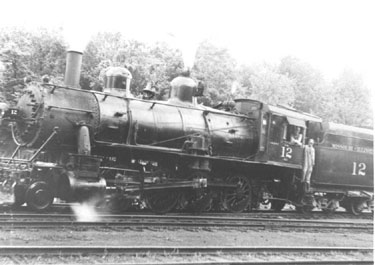 |
|
Missouri & Illinois 2-8-0 #12 Ste Genevieve,
Missouri. - David
Beckermann Collection
|
STE. GENEVIEVE,
MO - It isn't often that a man who helped build a railroad 53 years
ago is still around to talk about it. It is even more rare to find
such a person readily conversant with essential dates and related
facts.
That's exactly
the situation with Phil Eydmann, veteran engineer living here who
retired in 1943. The railroad in question is the Missouri-Illinois,
since 1929 a subsidiary of the Missouri Pacific Lines.
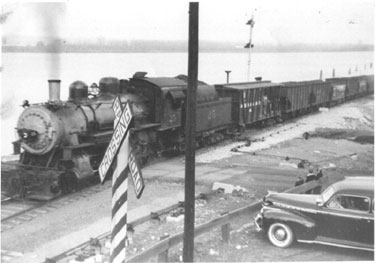 |
|
M&I #25 pulling a cut of cars up
the incline from the transfer boat, the "Ste Genevieve"
at Ste Genevieve, MO, on the Mississippi River. Notice the
idler car/caboose just behind the steam tender. The M-&I
had several of these cars, used to "reach" the
freight cars and draw them from the ferry without putting
the full weight of the locomotive on the deck. - David
Beckermann Collection
|
Crossed
on Sand Barge
Eydmann was
sent over by sand barge from Illinois with an engine to run a
work train on July 9, 1902. Thirteen months later he operated
the first passenger special for which rides were free. He kept
running trains for 40 more years before stepping aside to take
it easy. He is now 77 years old.
The veteran
engineer liked people and met a lot of them. He was interested
in facts, asked questions and remembered the answers. As a result,
general conversation with him produces many details little emphasized
if ever mentioned at all.
There are
two main parts of the Missouri-Illinois, often called the Mike
and Ike for obvious reasons. One runs from Bonne Terre to Riverside
and basically is the old Bonne Terre and Mississippi River railroad.
It plays little part in this story.
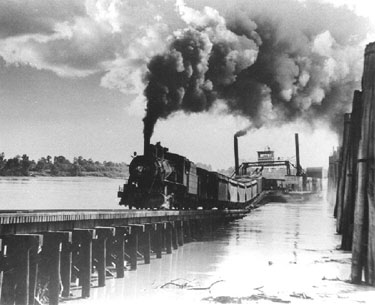 |
|
A
rather famous shot of
the 3rd "Ste Genevieve", the Missouri-Illinois rail car
ferry, which was retired in 1961. The Transfer Boat is seen
with a steam engine pulling a cut of cars off the deck.
The boat itself has two steam engines, one on each side,
with dual paddlewheels. - David
Beckermann Collection
|
The other
is the line that runs from Bismark to Salem, Ill. From the time
the sand barge brought Eydmann and engine to the newly made incline
here 53 years ago, the sections on each side of the Mississippi
have depended on a car ferry for crossing.
The present
boat, third in service, is the Ste. Genevieve, one of the few left
on the Father of the Waters.
The story
of this piece of railroad is inextricably woven into the fabulous
career of the late Chicago financier, John R. Walsh, whom Eydmann
met and talked with many times.
A yellow and
tattered clipping in the reference department of the Post-Dispatch
dated Dec. 24, 1905, devotes almost a page to a review of Walsh's
career. It describes him as a newsboy who became a multi-millionaire,
then was "ruined by the enemies he loved to make".
Born in 1837
in Ireland, he came with his parents in Gold Rush days to Chicago;
the city knew the family virtually from then on. Walsh died not
long after the story appeared.
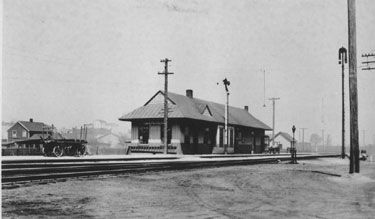 |
|
Here's an early shot of the old M&I
Depot in Ste. Genevieve, MO. The track closest to the camera
is the Frisco's mainline to St Louis. - David
Beckermann Collection
|
Headed
3 Banks
President
of three banks, he engaged in industrial activities that rivaled
the listings on the stock exchange board. Apparently the events
that led to building the line from Ste. Genevieve to Bismark started
when he loaned $400,000 to the old Centralia and Chester, an amount
which is one of the details supplied by Eydmann.
It went into
receivership in 1898; Walsh bought it to protect his interest
in May 1901. At that time he gave it the name Illinois Southern.
With a railroad on his hands, he decided to expand the system
by finding a new market for his Indiana coal holdings.
The Lead Belt
attracted his attention, leading to construction plans. Eydmann
recalls that originally the line was to go on to Salem, Mo., to
tap the timber resouces of that part of the state. Walsh's financial
difficulties ended that.
Another who
remenbers the same thing is Leo (Bill) Rehm, who worked at 17
on construction of the Missouri and Illinois and now is senior
conductor on the run to Bismark. He and Eydmann worked together
for years.
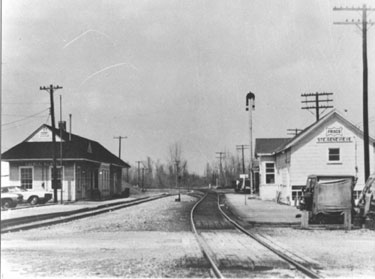 |
|
The Ste Genevieve depots, the M &
I / MoPac on the left and the Frisco on the right, sometime
in the mid to late 60's. The crossover track allowed M&I
trains to head south on the Frisco towards Cape Girardeau,
MO. The Frisco depot was demolished in the 80's, while the
MoPac depot survived until 2002. - David
Beckermann Collection
|
When Eydmann
arrived with the engine, there was only a little track beyond
the incline. There was also serious trouble ahead. Putting down
the new rail had progressed only into what is now downtown Ste.
Genevieve when difficulties developed with the Frisco.
That railroad,
having only recently taken over the old Hauck properties, wanted
to get on the inside nearest the town. After work stopped one
evening, the Frisco, Eydmann relates, put its own track across,
spiking it heavily in place. And then added two freight cars on
the crossing for good measure.
The Illinois
Southern construction foreman promptly directed Eydmann to "kick"
two cars of rails with his engine in such a way to overturn the
others. Before that the Frisco had gone to Hillsboro to get an
injunction against interference.
When Eydmann
complied, he, his fireman and 26 other men were put in jail by the
sheriff and held there 24 hours. This was about July 27, 1902. Legal
details were soon cleared to permit construction to continue.
The next major
obstacle was a natural one - the crossing of the valley of Rough
Creek. It required a bridge, still standing, which is 693 feet
long and 105 feet high in its tallest place. Work began, the retired
engineer recalls, on Sept. 1, 1902. He went over with the first
engine on Nov. 8 of the same year. In addition there were fills
of 500 feet on the west and 300 feet on the east.
The first
passenger service was from Ste. Genevieve to Bismark where connection
was made with an accommodation train to St. Louis. When the Frisco's
shorter line was completed, the service was changed. First it
was from Salem, then Chester to Bismark before being eliminated
entirely in November 1918.
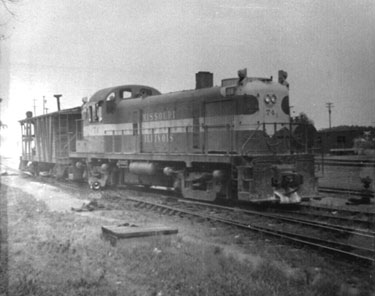 |
|
M&I #74, an Alco RS-3 unit and the
idler car/caboose sitting at the engine house at Ste Genevieve,
MO. Built in March 1955, Engine
#74 was later renumbered as MI 973, then MI 1092 before
finally being retired in February 1974. - David
Beckermann Collection
|
Financial
difficulties were brewing for the little road in that period.
They were brought to a head when the first Ste. Genevieve, also
the first regular transfer boat, sank on the Illinois side. This
boat was two-tracked and had a wooden hull.
Partly as
a result of its sinking, the road went into receivership, closing
down completely Dec. 12, 1919. When it reopened March 21, 1921,
it had been purchased by the St. Joseph Lead Company.
The original
Ste. Genevieve was replaced by the Kellogg, a two-track, 12-car
boat, which lasted only a year. At that time it was shifted to
Angola, La., for sand service where it sank. The present steel
hulled Ste. Genevieve, built in 1922 at Charleston, W.Va., started
in that year and has been on the job since. It can carry 18 cars
on three tracks, generally operates eight to 13 hours a day.
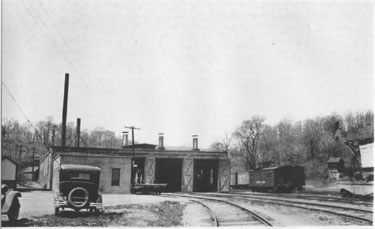 |
|
M&I enginehouse at Ste Genevieve,
MO with M&I caboose sitting on the lead. - David
Beckermann Collection
|
Eydmann, who
had been working in Bonne Terre at his original trade of machinist,
while the road was shut down, came back here as engineer, then served
as roundhouse foreman for the next 10 years.
When the line
resumed operation, the local freight crew switched the lime plant
just outside town, getting as many as 10 cars a day. Currently
it is the Mississippi Lime Co., a major industry, and shipments
averaging 75 cars daily are an economic mainstay of the railroad.
Not long ago 131 cars were billed out in one 24-hour period. Switch
crews work there round the clock.
Eydmann, born
near Marissa, Ill., on a farm, met his wife, the former Carrie D.
Yeager when boarding at her parent's home near Farmington in construction
days. A son, also named Phil, is a fireman here, qualified as an
engineer.
By
WAYNE LEEMAN, a staff correspondent of the St.Louis Post-Dispatch.
(1955)
Special thanks
to David Beckermann for sharing from his personal collection.

 |
Missouri
Illinois 4-4-0 #205
- the MoPac subsidiary's power is shown in a fireman's side view
with two passenger cars. On the white border, below the photo, Furler
wrote the name of the railroad, its length, and number of engines
and cars. - Donald W. Furler Photo/T. Greuter Collection
|
 |
Missouri-Illinois
#502
- a fireman's side view of a 2-8-2. - Donald W. Furler Photo/T.
Greuter Collection
|
 |
Missouri-Illinois
#1065
- this GP12 (ex-RS3) is caught pausing between chores. Taken in
the St Louis-Dupo area in the 1980's. - Jerry Carson Photo/T.
Greuter Collection ·
|
 |
MP/
M&I 50' "Cusion Car" from the late 70's at the rail
yard in Ste Genevieve, Missouri. The M & I boxcar had lost it's
MI reporting mark and been re-lettered MP. - Dave Beckermann
Photo
|
A Brief
History of the Missouri-Illinois
The Missouri-Illinois was part of MoPac's family since the steam-filled
days of April, 20 1929. M-I subsidiary MRBT (Mississippi River & Bonne
Terre) was leased by M-I. The
Missouri-Illinois was a major shortline running along both sides of
the Mississippi River south of St. Louis. It was wholly owned by the
Missouri Pacific from July 1, 1929 after the consolidation of a number
of Missouri and Illinois shortlines. The M-I served the rural parts
of Missouri and Illinois - for a small railroad it was an impressive
carrier of freight, mineral ore, coal, passengers, and even operated
a ferryboat transfer service, all in just 200 miles of mainline.
The Missouri-Illinois was originally formed in 1921 out of the banckrupt
Illinois Southern (itself the consolidation of the old Illinois Southern
and the Southern Missouri Railway - both created in 1900 to build a
route from Mississippi to Kansas City) The Illinois Southern suffered
a major disastor when it's steamship ferry sank in 1920, literally taking
half of the railroad with it, thus forcing the railroad out of business.
This foreclosure brought about the creation of the M-I, which took over
the line.
The Mississippi River & Bonne Terre RR (MR&BT) was the primary
subsidiary of the M-I. Formed on May 11, 1888 and spreading from Bonne
Terre northward to Riverside, Missouri and connecting to the St. Louis,
Iron Mountain & Southern, the MR&BT road operated over 66 miles
of railline at it's peak. It's primary resource was the wealthy mineral
stronghold of southeastern Missouri.
M-I is fondly
remembered for their ALCo diesels. The road bucked the EMD trend and
bought almost exclusively ALCo-built road switchers for their operations
(with the exception of a few EMD switch engines). First came a single
RS-2 (one of only four system-wide) The M-I must have liked the RS,
because for their next aquistion they again ignored the popular GP7
in preference for the new RS-3 roadswitcher, purchasing a total of 13
of these units, a third of the total aquired by the whole MoPac system.
These units had "Missouri Illinois" spelled out on their sides
in the blue and gray scheme. By the age of the screaming eagles, ownership
of these units was reduced to simple sublettering under the parent company's
emblem.
The
Missouri Pacific aquired a controlling interest in both the M-I and
the MR&BT on July 1st, 1929. These two shortlines were then consolidated
and the Missouri-Illinois ran as a subsidiary until October 25th, 1978.
The small Missouri-Illinois was the last railroad to officially fall
under the Mopac flag, being merged on November 1, 1978.
Sources:
Cabooses of the Missouri Pacific Lines, by G. J. Michels
Missouri Pacific Diesel Power, by Kevin EuDaly
|